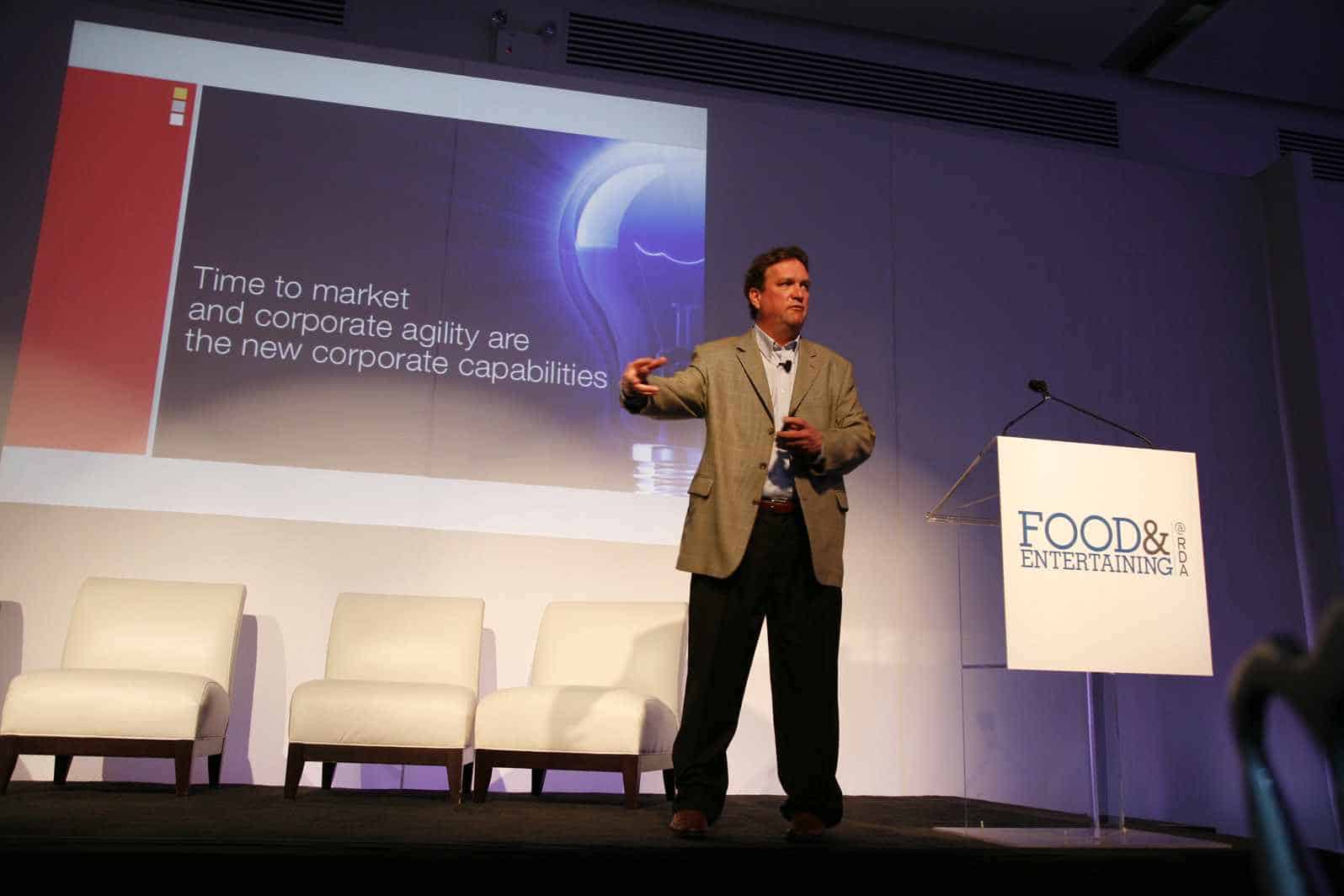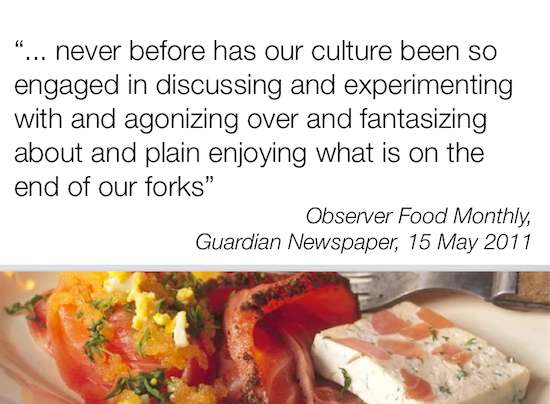It’s been a whirlwind of activity over the last two months, with about 20 major keynotes under my belt.
One of these was a corporate event for a food company with $7 billion in revenue and 24,000 employees ; my talk was on the key food industry trends of today that should be driving innovation from a marketing, product development and branding perspective.

This is one of many events I do for food and consumer product clients – my global client list includes high profile keynotes or leadership meetings for the Readers Digest Food & Entertainment Division (the publisher of such innovative magazines as Everyday with Rachel Ray), the Produce Marketing Association Annual Fresh Summit, HJ Heinz, Nestle , FMC FoodTechnologies, Burger King, Yum! Brands and many more.

I was the keynote speaker for a meeting of their top 250 marketing executives; my mandate was to focus on how to innovate around the trends that are today impacting the food industry today, with a particular focus on consumer behaviour.
Below are a few of the many trends that I spoke about. I took on an extensive amount of research for this keynote, which is typical of how I approach these events.
In effect, I built my keynote around the theme “….these are the trends that will drive your brands……”, and from that, they could best learn how to change and innovate with their branding and marketing message.
1. Biggest trend: We are witnessing a changing relationship with food
My main observation is that we live in a period of time that sees consumers interacting with food, the purchasing of food, and the consumption of food in new and different ways.
An article, Observer Food Monthly in the Guardian Newspaper, 15 May 2011 caught this sentiment perfectly:
- “… never before has our culture been so engaged in discussing and experimenting with and agonizing over and fantasizing about and plain enjoying what is on the end of our forks”
Consider what is happening:
- we have a new form of interaction when purchasing food. Consider the number of iPhone apps by which we can research calorie counts, nutrition facts and other information while in the grocery store.
- we have new influencers in how we make these in-store food decisions. Think about the Monterrey Aquarium Seafood Watch iPhone app, which will give you background that can help you with your ethical food decisions.
- a change in how we manage our food intake. iPhone and Web sites apps such as Lose It, which allow us to track our food consumption on a calorie-by-calorie, product by product basis.
- a change in food packaging: ““…..interactive packaging, intelligent and active packaging, multi-sensory packaging, edible packaging … packaging as mini-billboards…” as noted by the research firm Reportlinker. Paackaging is going from passive to active, and is becoming more than just the vehicle for branding – increasingly, it is defining our relationship with the food.
- a change in our food relationships. Consider the impact of food traceability based on DNA. “Tonning’s restaurant is among more than 11,000 that Richmond-based food distributor Performance Food Group is supplying with DNA-traceable beef as an added value for customers of its premium Braveheart brand. The company, which has annual revenues of about $11 billion, said it is among the first distributors to use the technology.” Where’s the beef, Iowa Press Citizen, May 2011
- A more direct involvement with the ethics of food. “Wal-Mart, which sells more than 20 per cent of all US groceries, is developing an eco-labelling program that will give a green rating to all items sold in its 7500 stores worldwide.” Unlikely alliance, Sydney Morning Herald, February 2011
- and very significant transitional trends. “Whole grains are the hottest trend in sliced bread, with whole wheat edging out soft white bread in total sales for the first time……… The whole-grain craze has, after all, raised the bar on what consumers are willing to pay for bread that’s perceived as healthy…..” Grains gain ground; Focus on healthy eating helps wheat surpass white in sliced bread sales 1 August 2010, Chicago Tribune
All in all, these are pretty significant, systemic, long term transformative trends that will have a major impact through the next 5-10 years. Smart food companies will recognize that the very nature of our relationship with food is changing and will innovative around that reality. Massive opportunities for innovative thinking exist here!
2. A need to respond to faster consumer preference/taste change
I’ve long been pointing out that consumer preference is changing faster when it comes to food, and that leads to the rapid emergence of new opportunity, or the rapid decline of existing product lines. A few of my observations:
- behavioural change and food as fashion! Fresh-cut snack food grew from $6.8 billion in to $10.5 billion in one year. Notes one publication: “Snacks are like a fashion category…..People want a change. it’s going to be short-lived–maybe a quarter, maybe six months, then changed out” Private Label Buyer, May 2010.
- We spend more of our day with our food – it’s not just breakfast, lunch and dinner anymore. Canadian consumers are snacking more frequently. Snacks were 24% of all “meals” consumed by 2010. Fruit leads in the category, and healthy snacks are driving growth – the top 7 snacks include yogurt and granola bars.
- Food categories can explode in growth over night. US Greek Yogurt sales grew from $33million in 2007 to $469 million today!
The key point with all of these trends is that it reflects our busy, compressed lives — smart food companies will continue to learn how to innovate within that reality with new products, aligning themselves to health concerns, and other trends.
3. The impact of business model change and social networks on food and taste trends

Clearly, massive connectivity is coming to influence the growth of new foods, brands, tastes, patterns.
I spoke, for example, how bacon has quickly become so trendy as something used to enhance countless recipes. It can be traced right back to an effective social networking campaign.
- “If there’s one food trend that illustrates how top-down and grassroots phenomena combine it might be bacon….. in southern California about six years ago, Rocco Loosbrock paired peppered bacon with Syrah wine at a tasting….”swine and wine…..!” The mysteries of food trends: How bacon got its sizzle, Associated Press Newswires, March 2011
- In the last few years, we’ve seen an explosion in the number of pop-up restaurants and “Eat St” food – street food!
- what is happening here is a lower barrier to entry in terms of new restaurant start up cost — more people can get out and start out a restaurant as “street food”, and experiment with new, bold, and exotic tastes and flavors
- there’s also a very big trend underway that links restaurants and markets together in one location. Go to the restaurant, like the food and want to cook it at home next time? Visit the market in the same building, and buy the exact ingredients for that exact recipe. We call these Resto 2.0’s : for example, Murray’s Market in Ottawa, based on locally farmed food, “….sells cheeses, meats, produce and house-made foodstuffs, providing customers with many of the same raw ingredients they use as their restaurant next door.” Globe & Mail, June 1, 2011
- all of these trends involve a new breed of restaurateur / entrepreneur; they’ve learned to link these efforts with very effective social network campaigns. The result is that we now have even faster emergence of new taste trends. Smart food companies will learn how to innovate around the sheer velocity of what is occurring here – ‘faster is the new fast!’
My key point? Innovation is all about time to market … and the brand message needs to match the new speed metric…
4. A new consumer volatility
Back in 2009, I keynote global events for both Burger King and Yum! Brands. One of the major points in both keynotes was the consumer and public health concerns would come to drive more of a focus on a healthier diet; hence, the need for more aggressive innovation around a balanced menu that offered up more healthier choices.
Since then, looking back, it looks like one chain took the message to heart, and the other didn’t. Can you guess which ones?
What’s happened since then? Restaurant chains — and by extension, food companies — are discovering that consumer activity has become very volatile. They might talk of the need to go out and eat healthier, but then go out and continue to buy big, fat juicy cheeseburgers.
But then the news continues to hammer home the cold realities of North American food lifestyles, and the impact of childhood obesity.
- over the past 30 years, childhood obesity rates in North America have tripled
- 1 in 3 children are overweight or obese
- 1/3 of all children born in 2000 or later will suffer from diabetes at some point in their lives
- many others will face chronic obesity-related health problems like heart disease, high blood pressure, cancer, and asthma
Add to that new messages from Michelle Obama, Jamie Kennedy and other influencers around this debate — and all of a sudden, behaviour begins to change faster than people expect. Consider comments in the article Dining chains shape up menus ;Customers place low-cal orders now, 13 April 2011, USA Today
- :Something odd is afoot in restaurants where Americans have typically gone to gorge: healthier grub. This nutritional U-turn is taking place at some of the unlikeliest of eateries, including Denny’s, IHOP, Friendly’s, Sizzler and even at the nation’s biggest casual dining chain, Applebee’s, where the numbers are eye-popping.“
- “For the first two months of 2011, the top-selling entree at Applebee’s wasn’t a gloppy burger or flashy fajita plate. It was a sirloin and shrimp entree from the chain’s diet menu. This marks the first time that a low-calorie item ever ranked as the chain’s best seller for a single month — let alone two in a row.“
- “I’ve been in the restaurant business for 30 years, and I’ve never seen anything like this,” says Mike Archer, president of Applebee’s.
- “When Applebee’s launched the under-550-calorie menu in 2010, it didn’t immediately take off, says Archer. But after some tweaks, it caught fire early this year. It now accounts for up to 8% of sales”
8 percent of sales! For healthy options! The key innovation opportunity is to keep innovating with food and taste trends around trends such as health, local, regional. The consumer is volatile, and will change faster than ever before.
Key marketing and branding innovation points?
- consumer behaviour is now more unpredictable than ever before!
- sudden, dramatic shifts driven by sudden external influences or other pressures are the new reality
- it’s easy to abandon marketing momentum / commitment due to slowness of trend (i.e. healthy lifestyle – consumers say one thing, and do another!)
- yet success from ability to quickly rejig marketing message based on trend spikes – speed matters!
And so branding innovation is … sticking to the message behind the key trends, even if the trends unfold at a curious and unpredictable pace….
I spoke about many other trends within the keynote, particularly the impact of mobile marketing and moving into hyper-nice marketing. I’ll cover more of that later.
This is typical of the type of unique research I often do for a keynote. If you are interested in bringing me in to a leadership meeting at your corporate organization, feel free to give me a call!




GET IN TOUCH
Jim's Facebook page
You'll find Jim's latest videos on Youtube
Mastodon. What's on Jim's mind? Check his feed!
LinkedIn - reach out to Jim for a professional connection!
Flickr! Get inspired! A massive archive of all of Jim's daily inspirational quotes!
Instagram - the home for Jim's motivational mind!